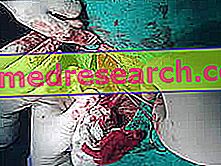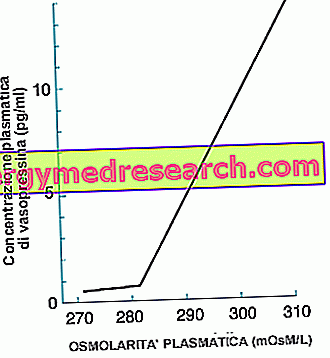Generality
Thyroidectomy is the surgical procedure used to remove all or part of the thyroid.

Figure: thyroidectomy intervention.
From the site: community.babycenter.com
The reasons that make it necessary to remove this organ, located in the anterior region of the neck, can be different; thyroidectomy, for example, can be practiced for thyroid cancer, for the presence of a thyroid nodule, for a condition of hyperthyroidism or for a goiter situation.
The surgical procedure, which can take place in at least three different ways, does not require special preparation, except in the case of hyperthyroidism.
Without the thyroid one cannot live; therefore, after a total thyroidectomy, it is necessary to plan an adequate replacement therapy based on synthetic thyroid hormones.
Brief review of the anatomy and functions of the thyroid
The thyroid is an unequal organ, located in the anterior region of the neck, at the base of the throat.
Similar in shape to a butterfly, the thyroid plays a very important physiological role, as it deals with regulating:
- Body metabolism (for example, affects oxygen consumption; controls the synthesis and degradation of cholesterol; stimulates lipolysis and lipogenesis; increases glycogenolysis and gluconeogenesis, etc.)
- Skeletal and cerebral development
- Protein synthesis
- The development of the skin, the piliferous apparatus and the genital organs
- The heartbeat
- Body temperature
- The hematopoiesis

Figure: the thyroid resides anteriorly to the larynx and trachea. It consists of two side lobes and a central part which is called the isthmus. Its weight is generally equivalent to about 20 grams, but it can undergo variations throughout life (for example during puberty, menopause, pregnancy, menstruation, breastfeeding, etc.). In women, it is smaller than in men.
To carry out all these regulatory activities, the thyroid uses three hormones that it produces by itself and injects into the blood. The hormones in question are: triiodothyronine (also called T3), thyroxine (also called T4) and calcitonin .
The own production of hormones and their introduction into the blood circulatory stream cause the thyroid to re-enter the list of human endocrine glands.
What is thyroidectomy?
Thyroidectomy is the surgical operation which removes all or only part of the thyroid (or thyroid gland ).
Without the thyroid and without its hormones one cannot live; therefore, if the entire thyroid gland is removed ( total thyroidectomy ), it is necessary to plan a pharmacological therapy based on synthetic thyroid hormones.
WHAT ARE EMITHEROIDECTOMY AND ISTMECTOMY?
When we talk about partial thyroidectomy, we distinguish the intervention of histmectomy from that of hemithyroidectomy.
- Histmectomy is the removal of the isthmus, the central region of the thyroid interposed between the two lobes.
- Hemithyroidectomy, on the other hand, is the removal of only one of the two lobes and the isthmus.
When you run
Thyroidectomy is practiced for the treatment of some thyroid disorders. The main reasons that require execution are:
- Cancer (or malignant tumor) of the thyroid . This is the reason that justifies most thyroidectomy interventions. This malign neoplasm arises when a thyroid cell undergoes an aberrant genetic mutation, due to which it begins to divide incessantly giving rise to a more or less consistent cell mass. This mass is not harmless, but tends to expand and spread its malignant cells in the rest of the body (metastasis).
The purpose of thyroidectomy, in case of thyroid cancer, is to eliminate the abnormal mass and any part of the thyroid affected by malignant cells.
- The presence of one or more thyroid nodules . A thyroid nodule is a benign tumor of the thyroid. It consists of the formation of an abnormal mass of cells, which, unlike thyroid cancer, do not have the same diffusion capacities.
Although it is benign, a nodule may require a thyroidectomy (with removal of the affected thyroid area), when it causes hyperthyroidism or compresses the neighboring organs (trachea and esophagus) causing fatigue (dyspnea) or swallowing (dysphagia).
- The goiter . Gozzo is the term used in medicine to indicate an increase in thyroid volume. An enlarged thyroid gland appears as a more or less evident and symmetrical bulge of the neck. Its onset may be due to various symptoms, such as: difficulty swallowing (dysphagia), difficulty breathing (dyspnea), problems with sound emission (dysphonia), hyperthyroidism or hypothyroidism.
In cases of more severe goiter, thyroidectomy could also be a total type.
- Hyperthyroidism . Hyperthyroidism is the medical term used to indicate a thyroid hyperfunction, with a consequent increase in thyroid hormones circulating in the blood. In addition to the presence of a thyroid nodule or a goiter condition, hyperthyroidism can also arise due to an autoimmune disease known as Graves' disease and Basedow's.
Attention: the portion of thyroid which must be eliminated depends on the severity of the thyroid disorders for which thyroidectomy is necessary.
risks
Thyroidectomy is a fairly simple and safe procedure. However, since it is still a surgical procedure, it is not completely free of risks and complications.
The potential dangers are represented by:
- Excessive blood loss, or bleeding .
- The development of a bacterial infection at the level of the operated area.
- An airway obstruction due to prolonged bleeding.
- A permanent change in the tone of the voice, due to damage to the recurrent nerve (or laryngeal nerve ) that controls phonation. The voice may become hoarse or weaker than normal.
- Damage of variable magnitude to one or more parathyroid glands, which are located exactly behind the thyroid.
The parathyroid glands, or parathyroid glands, control the levels of calcium in the blood, through the synthesis of a hormone fundamental for the human being, called parathormone (or PTH ).
- Complications due to anesthesia. As will be seen in the next chapters, general anesthesia is required, a delicate procedure that - even when performed correctly - can give rise to complications. For example, the patient may be allergic to an anesthetic drug and not know it.
- Hypothyroidism . It is a problem that could occur at the conclusion of total thyroidectomy, if the patient neglects to take synthetic thyroid hormones regularly or when the planned therapy is inadequate.
- Increased body weight . It is a possible consequence of post-surgical hypothyroidism.
Preparation
Thyroidectomy involves general anesthesia, therefore, on the day of the intervention, the patient must present himself to complete fasting (usually from the previous evening).
Failure to observe this pre-operative indication will result in the cancellation and postponement of the operation to another date, as the presence of food in the stomach could lead to suffocation.
Are any special medications to be taken before thyroidectomy due to hyperthyroidism?
In case of hyperthyroidism thyroidectomy, the patient is treated with a pharmacological preparation, based on potassium iodide ; this medicine, in fact, not only inhibits the synthesis of thyroid hormones, but also makes the glandular parenchyma more compact (a more compact glandular parenchyma is less prone to large blood losses).
The treatment based on potassium iodide must start 10-14 days before the date of intervention.
Procedure
The operating doctor, a surgeon, begins the actual thyroidectomy only after the patient has been sedated, anesthetized and connected to instruments intended to monitor some of his vital parameters (blood pressure, heart rate, etc.).
The surgery requires incisions to be made, either on the neck or on the chest; the site of the incisions depends on the chosen operating mode, which depends exclusively on the doctor's wishes.
The entire procedure, which must take place in an appropriately equipped operating room, can take up to an hour
GENERAL ANESTHESIA
General anesthesia involves the use of anesthetics and painkillers, which render the patient unconscious and insensitive to pain.
The administration of these drugs, carried out intravenously and / or by inhalation, occurs before and throughout the duration of the surgery.
At the end of the operation, in fact, the pharmacological treatment ceases to allow the patient to regain consciousness.
Upon awakening, it is likely that the operated person feels confused: it is a normal effect of anesthetics, which gradually fades within several hours.
MEASUREMENT OF VITAL PARAMETERS
The vital parameters measured are three:
- The heartbeat . The measurement takes place through electrodes, as in the case of an electrocardiogram.
- Blood pressure . It is measured through a band on the arm, similar to that used when the doctor uses the sphygmomanometer.
- Blood oxygen levels . The measurement is carried out using a special instrument, the oximeter, which is applied to a finger of the hand, because it is rich in blood vessels.
Keeping these parameters under control throughout the procedure is important, because it allows the entire medical staff (operating surgeon, assistants and nurses) to notice if something is not going well.
MODE? OPERATIONAL
There are at least three ways of performing a thyroidectomy:
- Traditional (or conventional ) thyroidectomy . It involves a single surgical incision, of a reasonable size, in the center of the neck, exactly in correspondence with the thyroid.
The amount of organ eliminated depends on the severity of the thyroid pathology in progress. Once the removal is complete, the incision is closed with stitches.
Traditional thyroidectomy is considered an invasive approach, also because it leaves a rather evident scar.
- Endoscopic (or minimally invasive ) thyroidectomy . This operation involves the execution of two very small incisions on the neck and the use of an instrument, the endoscope, equipped with a camera and connected to an external monitor. The surgeon uses these incisions to insert the endoscope into one, and the thyroid removal surgical instrument in the other. Clearly, to orient themselves inside the neck, the doctor uses the images projected by the camera on the external monitor. Endoscopic thyroidectomy is considered minimally invasive due to the small size of the incisions, which require few stitches and less time to heal.
- Trans-axillary robotic thyroidectomy . It is made by incisions of 7-8 centimeters, practiced at armpit level; therefore the neck is not touched. During the procedure, the surgeon uses a kind of robotic arms and a camera, connected to an external monitor, to orient himself with the instrumentation. The approach is invasive, but, unlike in the case of traditional thyroidectomy, the scar does not form in a visible point. Trans-axillary robotic thyroidectomy is a modern technique that is taking hold in recent years.
The choice of the operating mode rests exclusively with the surgeon: he generally decides according to the characteristics of the pathology and the state of health of the patient.
IN CASE OF THYROID CANCER

Figure: outcomes of a traditional thyroidectomy.
From the site: community.babycenter.com
In the case of thyroid cancer, removal of the lymph nodes near the gland is often necessary, as they could serve as a diffusion center for the malignant cells. With their elimination, therefore, we intend to prevent the appearance of metastases .
Post-operative phase
Immediately after thyroidectomy, the patient is taken to a hospitalization room, where he is kept under close observation until all the effects of anesthesia disappear. The latter could take up to several hours to disappear.
As soon as the patient proves that he has recovered satisfactorily and is stable, he is discharged. In general, discharges for thyroidectomy are performed after at least one day of hospitalization.
SURGICAL DRAINAGE
After thyroidectomy, it is very common for blood and other fluids to accumulate on the neck. To prevent these fluids from giving complications (especially during the night, when the patient sleeps), a drainage tube is applied until shortly before discharge.
POSSIBLE POST-OPERATOR DISORDERS
It is possible that, at the end of the operation, the neck is sore and the voice is weaker and hoarse.
However, unless there is permanent damage to the laryngeal nerve, they are two transient post-operative disorders, which resolve within a few days.
As far as eating and drinking are concerned, no particular restriction is foreseen and, in general, the patient is able to eat as before surgery.
BACK TO NORMALITY
For a fair recovery and a regular resumption of daily activities, you must wait at least 10 days. Obviously, much depends on the type of intervention: an endoscopic thyroidectomy, for example, has shorter recovery times compared to a traditional thyroidectomy or trans-axillary robotics.
Results
The effects of thyroidectomy depend on the portion of thyroid removed. A partial removal, in fact, will have different consequences from a total removal, since to be able to live without thyroid requires a constant intake of synthetic thyroid hormones .
PARTIAL THYROIDECTOMY
The part of the thyroid that remains, after a partial thyroidectomy, normally performs its functions, therefore it produces the hormones that the body needs.
Clearly, if the operation was performed due to an overactive thyroid (for example, in case of hyperthyroidism), it is hoped to have removed an adequate amount of glandular tissue; otherwise, the hyperthyroidism problem may reappear or hypothyroidism due to excessive removal may arise.
TOTAL THYROIDECTOMY
Synthetic thyroid hormones, containing levothyroxine, prevent hypothyroidism from complete thyroid deficiency. They reproduce exactly the functions of normal thyroid hormones.
To know in which doses are to be taken (each patient is a separate case) a specific blood test must be performed.



